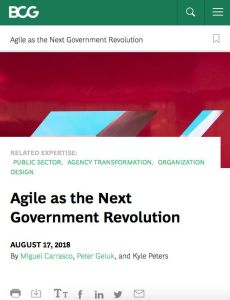Join getAbstract to access the summary!

Join getAbstract to access the summary!
Miguel Carrasco, Peter Geluk and Kyle Peters
Agile as the Next Government Revolution
Boston Consulting Group, 2018
What's inside?
Government operating models are underperforming, and agile offers solutions.
Recommendation
“With the gap widening between expectations and what’s being delivered, governments need to fundamentally transform the public-sector operating model,” explain Miguel Carrasco, Peter Geluk and Kyle Peters. These Boston Consulting Group professionals propose agile as the solution. Learn how and why government organizations should embrace agile transformations in this helpful overview.
Summary
About the Authors
Miguel Carrasco, Peter Geluk and Kyle Peters are professionals with the Boston Consulting Group.






















Comment on this summary